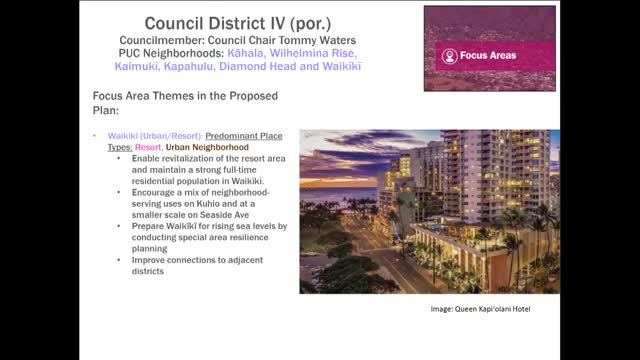City plans bold strategies to combat climate change impacts
August 13, 2024 | Honolulu City, Honolulu County, Hawaii

This article was created by AI summarizing key points discussed. AI makes mistakes, so for full details and context, please refer to the video of the full meeting. Please report any errors so we can fix them. Report an error »

In a recent government meeting, officials discussed critical infrastructure and urban planning initiatives aimed at addressing climate change, housing affordability, and community development in various districts. The discussions highlighted the urgent need for recommendations to extend the useful life of public infrastructure in Waikiki, particularly in light of rising sea levels and climate change impacts.
The meeting emphasized the importance of maintaining housing affordability while addressing drainage and flooding concerns in Council District Five, which includes areas such as Moili, Eli, and Macaulay. Officials noted the necessity of encouraging neighborly frontages and reducing front-loaded parking to enhance community aesthetics and functionality.
Plans for transforming key corridors into more walkable areas were also discussed, with a focus on King and Baritania streets. The ongoing evolution of Wilder Street into a neighborhood spine was highlighted as a significant development in the area. In Alamoana Kaka'ako, officials reported that much of the major transformation has already been completed, indicating a shift towards more integrated urban spaces.
Special districts, such as the Diamond Head and Waikiki special districts, were mentioned as crucial regulatory frameworks for preserving public views and guiding design in these areas. The meeting referenced older legacy plans that continue to inform current discussions, emphasizing the importance of community character and historical context in urban planning.
Maps illustrating coastal hazards, housing frameworks, and public use were presented, showcasing areas vulnerable to sea level rise and identifying potential adaptation strategies. The coastal hazards map indicated significant exposure to rising sea levels, urging planners to consider these factors in future developments.
Overall, the meeting underscored a comprehensive approach to urban planning that integrates climate resilience, community needs, and sustainable development practices, setting the stage for future initiatives aimed at enhancing the quality of life for residents while addressing pressing environmental challenges.
The meeting emphasized the importance of maintaining housing affordability while addressing drainage and flooding concerns in Council District Five, which includes areas such as Moili, Eli, and Macaulay. Officials noted the necessity of encouraging neighborly frontages and reducing front-loaded parking to enhance community aesthetics and functionality.
Plans for transforming key corridors into more walkable areas were also discussed, with a focus on King and Baritania streets. The ongoing evolution of Wilder Street into a neighborhood spine was highlighted as a significant development in the area. In Alamoana Kaka'ako, officials reported that much of the major transformation has already been completed, indicating a shift towards more integrated urban spaces.
Special districts, such as the Diamond Head and Waikiki special districts, were mentioned as crucial regulatory frameworks for preserving public views and guiding design in these areas. The meeting referenced older legacy plans that continue to inform current discussions, emphasizing the importance of community character and historical context in urban planning.
Maps illustrating coastal hazards, housing frameworks, and public use were presented, showcasing areas vulnerable to sea level rise and identifying potential adaptation strategies. The coastal hazards map indicated significant exposure to rising sea levels, urging planners to consider these factors in future developments.
Overall, the meeting underscored a comprehensive approach to urban planning that integrates climate resilience, community needs, and sustainable development practices, setting the stage for future initiatives aimed at enhancing the quality of life for residents while addressing pressing environmental challenges.
View full meeting
This article is based on a recent meeting—watch the full video and explore the complete transcript for deeper insights into the discussion.
View full meeting
